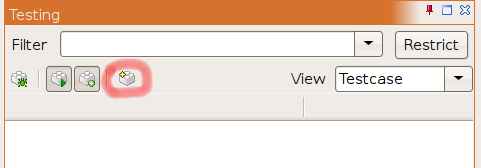Difference between revisions of "Using CDD"
(→How to extract a test case) |
|||
| Line 37: | Line 37: | ||
= How to extract a test case = | = How to extract a test case = | ||
| + | |||
| + | CDD automatically extracts a new test case after every thrown exception. This test case will appear in the normal test case tool window and can be managed like an ordinary manually written test case. | ||
= How to search for a test case = | = How to search for a test case = | ||
Revision as of 05:52, 28 January 2008
Contents
Getting Started
- First you need to make the two CDD tool windows 'Testing' and 'CDD Output' visible. Do that by going to the menu 'View -> Tools' and select 'Testing' and 'CDD Output':
- Now enable background execution and extraction of test cases. The first will cause the execution of your test cases after every compilation and the second will extract a new test case after every exception. To enable both make sure both of the toolbar buttons (marked in red) below are pressed.
How to add a manual test case
To add a manual test case simply create a new class whose name contains the word 'TEST', have it inherit from CDD_TEST_CASE and add one or several unit test routines. Make sure that all unit test routines start with 'test_'. Here is a simple example test class:
class TEST_BANK_ACCOUNT inherit CDD_TEST_CASE feature test_deposit local ba: BANK_ACCOUNT do create ba.make_with_balance (0) ba.deposit (100) check money_depisited: ba.balance = 100 end end end
After you have added your test class, recompile and your test case should automatially appear in the 'Testing' tool window. A template test case can created by pressing the 'Create new manual test case' button:
How to extract a test case
CDD automatically extracts a new test case after every thrown exception. This test case will appear in the normal test case tool window and can be managed like an ordinary manually written test case.




